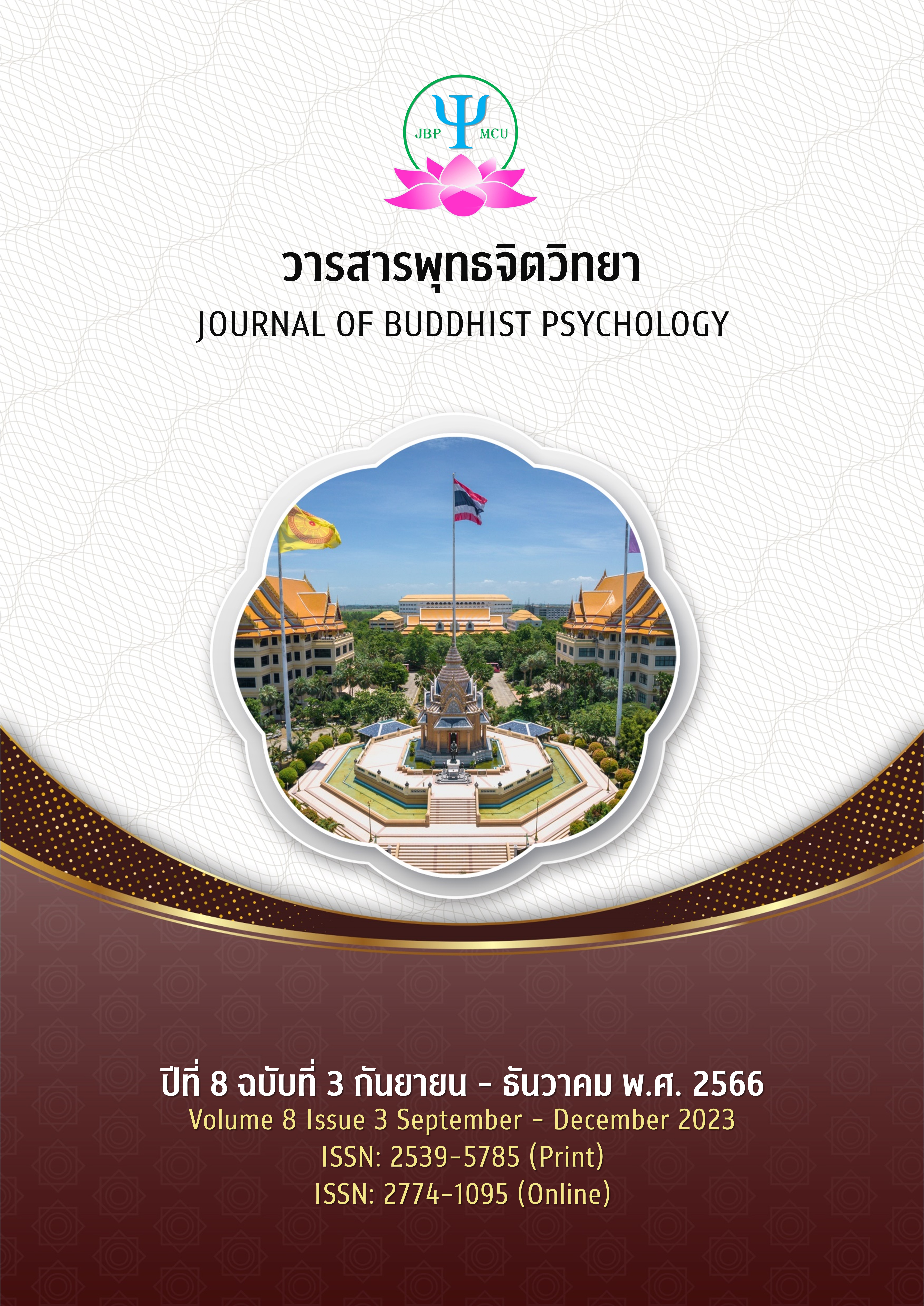The Imagination of Passing and Designing for Life of the Aging Who Lives in the Big Municipal
Main Article Content
Abstract
This research aims to study 1) the imagination of death and 2) designing for the life of the aging people residing in Bangkok Metropolitan. The qualitative research method in-depth interviews with 12 key informants, 6 equally male and female, aged between 56-88 years. Analyze data by comparing content presented from interviews and summarizing the phenomena.
The results showed that imagination toward death has 4 aspects: 1) concreteness in biology when the body stops working and 2) Abstract perception related to their own religious beliefs.
3) Expectations when near death are natural death does not prolong life, knowing about the treatment of disease, good death preparation, and choosing the place to die at home rather than a hospital.4) Belief after death, believed that reincarnation to other realms depends on the sin or merits committed in one’s life. Generate good karma by donating body, blood, property, and things, making merit, and not encroaching on other people’s lives.
Designing for life has three aspects: 1) Social and cultural, consisting of having a group of friends to talk to or come to see each other, believing in one’s ability, being independent and self-reliant, and returning to their hometown at the age of being dependent on others. 2) Economically, there is property management, having sufficient savings for living, 3) Health and learning, paying attention to physical health, nutrients, exercise, and brain training, learning from hobbies, informal learning from life experiences, reading, listening, meeting friends, and hobbies. Follow the news on television and mobile phone. The research results can be applied to preparation for pre-aging information, continuing education for seniors, and training for elderly caregivers.
Article Details

This work is licensed under a Creative Commons Attribution-NonCommercial-NoDerivatives 4.0 International License.
References
กรมกิจการผู้สูงอายุ. (2563). มาตรการขับเคลื่อนสังคมสูงวัยคนไทยอายุยืน 4 มิติ เศรษฐกิจ สภาพแวดล้อม สุขภาพและสังคม. กรุงเทพฯ: กองยุทธศาสตร์และแผนงาน.
กรมสุขภาพจิต. (2558). คู่มือความสุข 5 มิติสำหรับผู้สูงอายุ.ฉบับปรับปรุงครั้งที่ 6. กรุงเทพฯ: สำนักส่งเสริมและพัฒนาสุขภาพจิต.
พระครูอรรถจริยานุวัตร. (2564). การเตรียมตัวตายตามแนวพระพุทธศาสนา. วารสารวิชาการโรงเรียนนายเรือ ด้านสังคมศาสตร์ มนุษยศาสตร์ และศึกษาศาสตร์, 8(1), 55-65.
พระไตรปิฎกวิจารณ์. (2509). พระพุทธศาสนากับการเกิดใหม่ ความสำคัญของพระไตรปิฎก. กรุงเทพฯ:มหาวิทยาลัยมหาจุฬาลงกรณราชวิทยาลัย.
พระไพศาล วิสาโล และคณะ. (2552). เผชิญความตายอย่างสงบ 2. พิมพ์ครั้งที่ 1 . กรุงเทพฯ: เครือข่ายพุทธิกา.
พระมหาคมคาย สิริปญฺโญ (สิงห์ทอง), พระสุชาติ เชื้อรุ่ง. (2565). ความตายในมุมมอง 4 ศาสนา. วารสารปรัชญาปริทรรศน์, 27 (2), 284-302.
พระมหาจักรพันธ์ จกฺกวโร. (2564). ไตรสิกขากับการดำเนินชีวิตของชาวพุทธ. ตาก: วิทยบริการ มหาวิทยาลัยมหาจุฬาลงกรณราชวิทยาลัย จังหวัดตาก.
นงลักษณ์ พะไกยะ. (2561). รายงานความต้องการกำลังคนด้านสุขภาพในการดูแลผู้สูงอายุ. นนทบุรี: สถาบันวิจัยระบบสาธารณสุข.
มารยาท สุจริตวรกุล; สิริลักษณ์ โสมานุสรณ์. (2561). ปัจจัยที่มีความสัมพันธ์กับการเตรียมตัวเพื่อการตายของผู้สูงอายุไทยพุทธ. วารสารเกื้อการุณย์ (25) 1. 154-169.
ยุพา ทองสุข. (2559). ปัจจัยที่มีอิทธิพลต่อความผาสุกทางใจของผู้สูงอายุ. (วิทยานิพนธ์พยาบาลศาสตรมหาบัณฑิต) คณะพยาบาลศาสตร์ มหาวิทยาลัยบูรพา.
สายสิริ อิสรชาญวาณิชย์. (2560). การวางแผนการดูแลในระยะท้ายของชีวิตล่วงหน้า.โครงการขับเคลื่อนแผนยุทธศาสตร์ระดับชาติว่าด้วยการสร้างเสริมสุขภาวะในระยะท้ายของชีวิต พ.ศ.2557-2559. สถาบันวิจัยระบบสาธารณสุข. กระทรวงสาธารณสุข นนทบุรี.
สำนักงานสถิติแห่งชาติ. (2560). การสำรวจประชากรสูงอายุในประเทศไทย 2560. สืบค้นเมื่อ 5 ธันวาคม 2562 จาก http://www.nso.go.th/sites/2014 /Pages/News/2561/N10-17-2561.aspx
Elizabeth, A. P., Lynda, A. A. (2020). Older Adults' Views of Successful Aging. Retrieved March 7, 2020, from https://www.ncbi.nlm.nih.gov/pubmed/14286297
Forum Qualitative. (2010). The Theme-centered Interview. Journal of Forum Qualitative Socialization, 1(2), 23.
Health Foundation. (2019). A Guide for Designing and Conducting In-Depth Interviews. Retrieved May 6, 2020, from https://nyhealthfoundation.org/wp-content/uploads/2019/02/me _tool_series_indepth_interviews-1.pdf
Heather Fuller. (2018). Multiple Factors Influencing Successful Aging. Retrieved March 7, 2020, from https://www.ncbi.nlm.nih.gov/pmc/articles/PMC6841199/
National Institute on Aging. (2020). How the Aging Brain Affects Thinking. Retrieved September 12, 2022, from https://www.nia.nih.gov/health/how-aging-brain-affects-thinking
Tana Nilchaigowit, Warisara Krikhaiwan. (2003). The situation of death and dying paradigm shift. Health Systems Research Institute (HSRI). Retrieved March 7, 2020, from http://kb.hsri. or.th/dspace/handle/11228/1494.
TDRI. (2562). เดินหน้าสู่สังคมผู้สูงอายุ “ประเทศไทย” Thailand Development Research Institute. สืบค้นเมื่อ 5 ธันวาคม 2562, จาก https://www.finnomena.com/mr- messenger/aged-society/.
WHO. (2010). Global Network for Age-friendly Cities and Communities. Retrieved 6 December, 2021, from https://www.who.int/ ageing/projects/age_friendly cities_ network/en/

